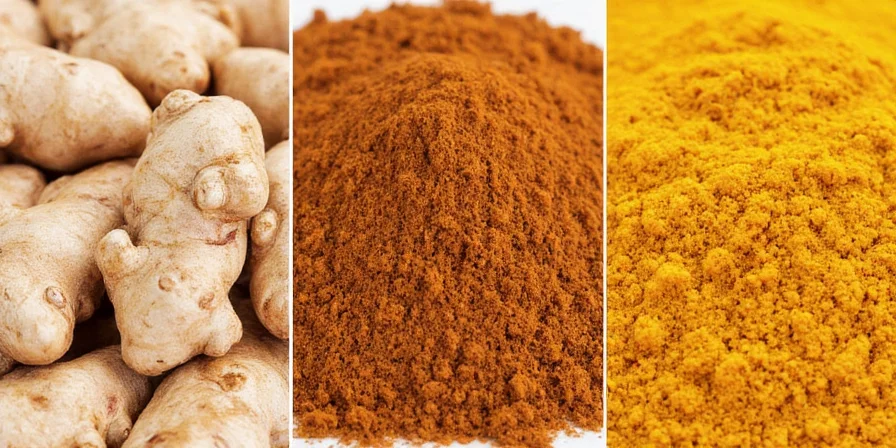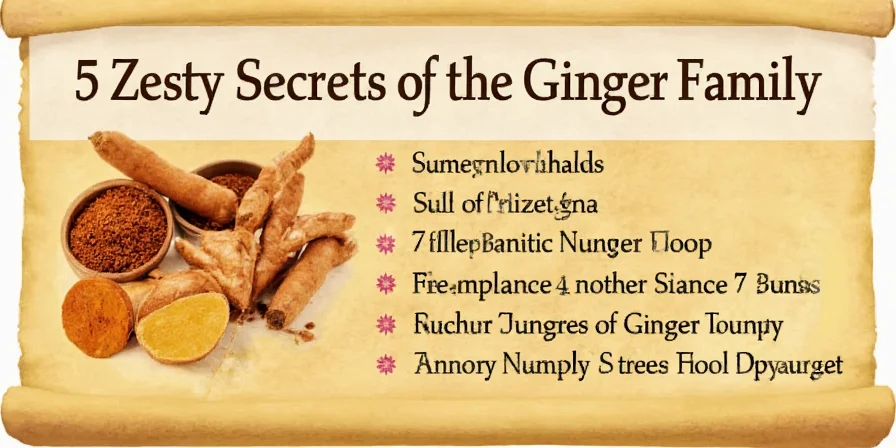The true ginger family (Zingiberaceae) consists of ginger, turmeric, cardamom, and galangal—botanically related spices with shared chemical properties that transform cooking. Unlike common misconceptions, cumin belongs to a different plant family (Apiaceae) and isn't part of this group. This definitive guide reveals science-backed flavor profiles, precise culinary applications, heat interaction chemistry, and professional techniques for using these aromatic powerhouses. Discover why these spices behave differently in cooking, how to maximize their potential, and avoid critical mistakes most home cooks make.
Table of Contents
- Zingiberaceae Explained: What Makes a True Ginger Family Spice
- Ginger: The Pungent Pioneer
- Turmeric: The Golden Transformer
- Cardamom: The Floral Complexity
- Galangal: The Citrus-Pine Specialist
- Comparison Table: Zingiberaceae Family Members
- The Chemical Dance: How Heat Transforms Zingiberaceae Compounds
- Pro Tips for Cooking with True Ginger Family Spices
- Common Mistakes (Including the Cumin Confusion)
- Conclusion: Mastering the Real Ginger Family
Zingiberaceae Explained: What Makes a True Ginger Family Spice
The ginger family refers specifically to the Zingiberaceae botanical family, comprising over 1,300 species including ginger, turmeric, cardamom, and galangal. These spices share rhizome-based growth patterns and similar chemical compounds like terpenes and phenolics that create their distinctive aromas and flavors. Crucially, cumin is not part of this family—it belongs to Apiaceae (the parsley family), explaining why its flavor chemistry behaves differently in cooking. This botanical accuracy matters because:
- Zingiberaceae spices interact similarly with heat and other ingredients
- They share common volatile compounds affected by cooking methods
- Misidentifying family members leads to culinary mistakes (like substituting cumin for galangal)

Ginger: The Pungent Pioneer
Ginger (Zingiber officinale) is the original Zingiberaceae member, with its pungent warmth defining both medicinal tonics and gourmet dishes across Asian and Middle Eastern cuisines for millennia.
Flavor Chemistry:
- Primary compound: Gingerol (converts to milder zingerone above 140°F/60°C)
- Pungency level: High (decreases significantly with cooking)
- Flavor evolution: Fresh = bright/citrusy; Cooked = mellow/earthy
Optimal Culinary Applications:
- Raw applications: Grated into dressings, smoothies, and ceviche (maximizes gingerol)
- Cooked applications: Added early in stir-fries for mellow warmth
- Baking: Use crystallized ginger for controlled sweetness in desserts
Turmeric: The Golden Transformer
Turmeric (Curcuma longa) delivers vibrant color and earthy depth through curcuminoids. Its traditional use spans Ayurvedic medicine and Southeast Asian kitchens, but requires specific handling for optimal results.

Flavor Chemistry:
- Primary compound: Curcumin (bioavailable only with fats + piperine)
- Color stability: Degrades with prolonged heat exposure
- Flavor profile: Earthy with subtle bitterness that mellows when cooked
Optimal Culinary Applications:
- Golden milk: Must include black pepper and coconut oil for absorption
- Rice dishes: Add during last 5 minutes of cooking to preserve color
- Marinades: Pair with acidic ingredients to stabilize color
Cardamom: The Floral Complexity
Cardamom's fragrant pods—green (Elettaria cardamomum) and black (Amomum subulatum) varieties—bring sweet complexity through volatile oils that degrade quickly with heat exposure.

Flavor Chemistry:
- Primary compounds: 1,8-cineole and α-terpinyl acetate (volatile oils)
- Heat sensitivity: Loses 70% of aroma compounds after 10 minutes simmering
- Flavor evolution: Raw = intense floral; Cooked = mellow citrus
Optimal Culinary Applications:
- Chai: Add during last 2 minutes of brewing to preserve aroma
- Desserts: Use whole pods in rice pudding, removed before serving
- Meat rubs: Grind with coriander for balanced earthiness
Galangal: The Citrus-Pine Specialist
Galangal (Alpinia galanga) offers sharper, more complex notes than ginger through different terpene compounds. Essential in Thai and Indonesian cuisine, it provides distinctive flavor notes that withstand cooking better than ginger.

Flavor Chemistry:
- Primary compounds: 1,8-cineole and α-pinene (more heat-stable than gingerol)
- Heat tolerance: Maintains 80% flavor compounds after 20 minutes boiling
- Flavor profile: Woody and citrusy with pine-like sharpness
Optimal Culinary Applications:
- Tom Kha Gai: Slice thinly and add at beginning of cooking
- Curry pastes: Pound with lemongrass for authentic flavor base
- Herbal preparations: Simmer whole for maximum extraction
Comparison Table: True Zingiberaceae Family Members
| Spice | Botanical Name | Key Compounds | Heat Tolerance | Signature Culinary Use |
|---|---|---|---|---|
| Ginger | Zingiber officinale | Gingerol → Zingerone | Low (degrades rapidly) | Raw applications, quick-cook dishes |
| Turmeric | Curcuma longa | Curcuminoids | Moderate (color degrades) | Golden milk (with pepper + fat) |
| Cardamom | Elettaria cardamomum | 1,8-cineole | Very low (volatile oils) | Chai (added late in brewing) |
| Galangal | Alpinia galanga | α-Pinene, 1,8-cineole | High (heat-stable) | Thai soups (added early) |
The Chemical Dance: How Heat Transforms Zingiberaceae Compounds
Understanding the precise chemical transformations in Zingiberaceae spices explains why cooking techniques matter:
- Ginger: Gingerol (pungent) converts to zingerone (milder) at 140°F (60°C), explaining why cooked ginger loses sharpness. For maximum heat, add raw ginger in final cooking stages.
- Turmeric: Curcumin bioavailability increases 2,000% when combined with black pepper (piperine) and fats—critical for golden milk efficacy. Simmer color-sensitive dishes for under 5 minutes to prevent fading.
- Cardamom: Volatile oils (1,8-cineole) degrade rapidly; 70% aroma lost after 10 minutes simmering. Always add to chai during final brewing minutes.
- Galangal: α-Pinene withstands boiling, making it ideal for soups where ginger would lose potency. Its fibrous texture requires different preparation than ginger.
Pro Tips for Cooking with True Ginger Family Spices
Transform your dishes with these science-informed techniques:
- Temperature Control: Ginger degrades below boiling point—add in last 2 minutes of cooking for preserved pungency. Turmeric needs 5-7 minutes simmering for optimal color (but not longer).
- Fresh vs. Ground: Fresh ginger and turmeric offer brighter notes with active enzymes; ground versions provide earthier depth. Smell before use—faded aroma means reduced potency.
- Timing Matters: Add cardamom late in cooking to preserve volatile oils. Introduce galangal early for soups to mellow its sharpness while maintaining structure.
- Smart Pairings: Turmeric + coconut oil + black pepper boosts absorption 2,000%. Galangal + lemongrass forms Thai cuisine's flavor backbone.
- Storage: Keep whole spices in airtight containers away from light. Freeze fresh ginger and turmeric in vacuum-sealed bags for 6+ months.

Common Mistakes (Including the Cumin Confusion)
Avoid these critical errors that undermine your cooking:
- The Cumin Error: Cumin (Apiaceae family) has completely different chemistry than Zingiberaceae spices. Never substitute cumin for galangal or cardamom—flavor profiles don't align.
- Overcooking Cardamom: Adding cardamom at beginning of chai brewing destroys 70% of its signature aroma compounds. Add during last 2 minutes.
- Ignoring Turmeric's Requirements: Golden milk without black pepper and fat has 99% less curcumin absorption—rendering it nearly ineffective.
- Misjudging Ginger Heat: Cooked ginger has only 30% of raw ginger's pungency—adjust quantities accordingly when substituting forms.
- Improper Storage: Ground spices lose potency within 6 months; whole spices retain quality for 1-2 years when properly stored.
Conclusion: Mastering the Real Ginger Family
The Zingiberaceae family (ginger, turmeric, cardamom, galangal) offers distinct chemical personalities that transform cooking when understood properly. By recognizing their unique heat interactions, storage requirements, and culinary applications—while avoiding the common cumin confusion—you unlock precision beyond basic recipes. These spices connect modern kitchens to centuries of global tradition through scientifically informed usage that respects their botanical reality.

Frequently Asked Questions
What defines the true ginger family of spices?
The Zingiberaceae botanical family includes ginger, turmeric, cardamom, and galangal. These share rhizome-based growth and similar chemical compounds. Cumin belongs to a different family (Apiaceae) and isn't related.
Why does my turmeric dish lose color during cooking?
Turmeric's curcumin degrades with prolonged heat exposure. For maximum color retention, add turmeric during the last 5 minutes of cooking and pair with acidic ingredients.
Can I substitute galangal for ginger?
Only in specific Southeast Asian recipes. Galangal has sharper citrus-pine notes and less heat. It withstands cooking better but doesn't provide the same flavor profile as ginger.
How should I store fresh Zingiberaceae spices?
Wrap in paper towels, place in airtight containers, and refrigerate. They'll last 2-3 weeks. For longer storage, freeze whole roots in vacuum-sealed bags and grate frozen.
Do these spices lose potency differently?
Yes—each Zingiberaceae member degrades at different rates: Cardamom (volatile oils) degrades fastest (70% in 10 min), ginger (moderate), turmeric (color fades), galangal (most stable). Whole spices retain potency for 1-2 years when stored properly.











 浙公网安备
33010002000092号
浙公网安备
33010002000092号 浙B2-20120091-4
浙B2-20120091-4